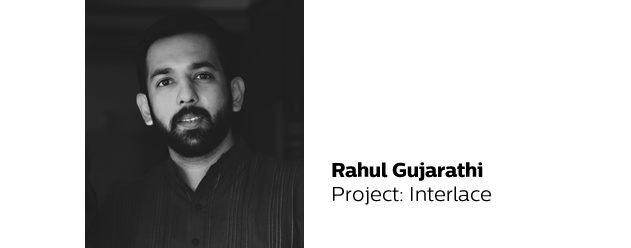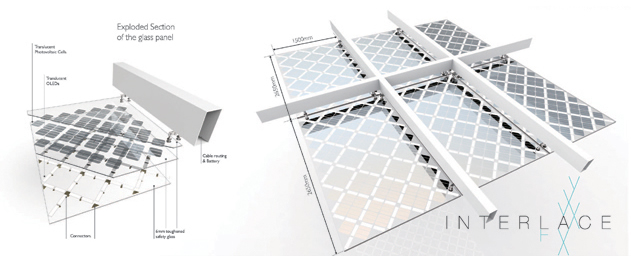The project Interlace by Rahul Gujarathi is an elegant composition, said jury member, Randy Burkett. “It’s two technologies woven together to serve the user and occupant. A near endless number of manifestations seem possible with the creative application of this approach in building design. Definining a timeless and traditional boundry this is innately linked to light and the environment, in an exciting and artistic manner. Connection, protection, interaction – all present at this border. This project, more than most, looks forward at the ultimate integration of technology and human needs.”
Tell me about yourself, your career and your education.
My name is Rahul Gujarathi and I am a highly motivated industrial designer looking for challenges and experiences that enrich my life. I studied architecture for my bachelor degree in India (University of Pune) and later I continued my design education with a master in Industrial Design from the Industrial Design Centre at Indian Institute of Technology Bombay. I am currently working in Singapore as a Research Associate at TUM CREATE where we develop electric mobility solutions for tropical megacities.
 |
|
(All photos courtesy of Philips) |
Where does your interest in lighting design come from?
I have always been intrigued by lighting and its ability to create atmosphere and transform mood. My first encounter with lighting was through architecture and how the structure is designed to sculpt natural light and create an interesting poetic space. Later I got interested in luminaire design with increasing inclination towards changing lighting technology.
Why did you choose to participate in the Interface themed CLUE Competition?
This is the first time I came across CLUE Competition and found the theme very interesting. I really liked the fact that it had overlapping concerns between the architectural/urban scale and product/luminaire scale. Thus I was able to use my experience from both architecture and industrial design education to analyse the theme and develop ‘Interlace’.
Can you share with us your initial idea behind this concept of Interlace and what is the interface aspect of this project?
I was intrigued by the theme ‘Interface’ and wanted to explore this concept in a direction of how I could create a product, an intervention on the edge; a relation between the built and the un-built. Concept ‘Interlace’ is an integrated structural glazing system which forms a meaningful interface between the interior and the exterior by incorporating photovoltaic cells and OLEDs in a single system. The glass thus becomes a living interface at the edge, absorbing solar radiation from outside and powering OLEDs for lighting up the interiors.
It makes the existence of glass even more meaningful. Exterior glazing is very popular in modern architecture but then solar radiation has always been a concern considering it increases the load on the air-conditioning system to cool the interior. As a result some sort of solar blocking systems like louvers/blinds, films, coatings etc. are required to be implemented along with glass. ‘Interlace’ provides an integrated and efficient solution to these issues while providing a chic, modern visual.
Do you think that your proposal could become a reality?
Yes, I firmly believe that my proposal could become a reality as it is based on technologies that are already on the market. I have been following the development of the OLED technology by Philips Lumiblade and have designed by concept around the rectangular OLED panel released in 2012.
I would be keen on developing this concept further to become a reality, if possible together or with support from Philips.
What were your motivations for Interlace?
One of the motivations for this project was the observation that glass has been an extremely popular material for external cladding, especially in tropical countries where climatically it doesn’t seem very appropriate to use glass for the exterior. I wanted to design something that improves this popular existence of glass and makes it a more sensible choice of material. My approach was more towards designing a material rather than an object.
Please tell us more about the operational aspect of your installation. How does it work?
‘Interlace’ is an insulated structural glass panel, which sandwiches a system of OLEDs in one layer and a system of energy harnessing photovoltaic cells in another layer. As these panels are planned to be used for exterior glazing the photovoltaic cells harness solar energy from the sun and store them into batteries. Later as the sun goes down, this energy harnessed is used to power up the OLEDs.
The glass being triple glazed provides good insulation for the interior, while the use of translucent PV cells and OLEDs helps in reducing the unwanted solar glare, yet maintaining an intimate transparency. The glass panels get connected with each other with male-female connectors on the periphery and form a huge interconnected surface or system.
This opens up a huge pool of possibilities on how we could use this system depending on where it is employed; it might be used for art/installations or for directing crowd in urban areas in a more intuitive manner or it could simply be ambient lighting for streets or corridors.
How do you see lighting design evolving on a long-term basis?
Lighting technology has rapidly evolved in the last few years making it more energy efficient, cost efficient and stretching boundaries like the colour of light. All this has led to new applications of lighting ranging from light therapy to agriculture to installations in urban areas to name a few. I see lighting design to evolve in the future to become an integral part of the nature and have a seamless transition between the natural and the artificial lighting. Energy harnessing and alternatives to electricity to power light might gain importance in the future and also might change the way we see light today.
How do you see your professional career evolving?
I see myself continuing to develop interesting innovative solutions and finding appropriate application for new developing technologies that will change, challenge and improve the existing. I want to work for a company driven by passion and where I am able to develop state of the art solutions for the near future. It is my dream to see people satisfied using my solutions implemented in the real world.














